Terry's Surgery - Finally
- Details
- Written by Kevin Horton
- Hits: 3705
Terry finally had surgery to remove a bulging disc in her neck, and fuse the two vertebrae that were above and below that disc. It took about eight weeks from when she was put on the waiting list until she had the surgery. She had two previous scheduled surgery dates, the two weeks before, but both times the surgery was delayed a week or so, as there would be no room available for her on a ward after the surgery. The swine flu “pandemic” has put many people in hospital, and this has created bed shortages.
Her surgery on Wednesday went well, but it turned out that several patients who had been expected to be discharged from the hospital had to stay another day. Terry was one of nine patients who had surgery, but then had no bed available on a ward. They spent the night in the recovery room. She finally got a bed in a room on the Neurosciences ward on Thursday at lunch time. She spent two nights in the hospital, and I picked her up to bring her home late Friday morning.
She is wearing a cervical collar to keep her neck immobilized while those two vertebrae fuse together. This makes it hard for her to do many normal activities, so we spent much of the last two days figuring out practical workarounds. It still isn’t clear whether the surgery has solved the pain she was having in her shoulders and arms. The pain is much less frequent, but it is still there once in a while. We’re hoping that the pain she is still having is due to swelling around the area of surgery, and that it will go away as she heals. Hopefully she will be able to go back to work sometime next year.
I didn’t get flying this weekend, as I really need to spend time helping Terry do all the things she used to be able to do by herself. Yesterday was sunny, but there was a howling crosswind, so I couldn’t have flown anyway. I eventually hope to expand the crosswind envelope to 25 kt, or more. But I don’t want to go all the way there in one step. So far, I’ve flown in crosswinds of about 10 to 12 kt. I’m looking for something around 15 kt or so for the next step in the crosswind expansion.
ILS Check Flight
- Details
- Written by Kevin Horton
- Hits: 4649
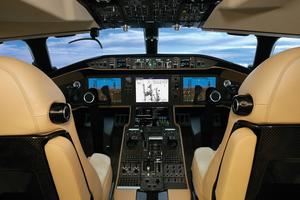 I was on the road for four days last week, in Wichita for the first ground test evaluations of the new Rockwell Collins Proline Fusion (550 kB PDF) avionics suite that is the main element of the Global Vision Flightdeck update on the Global Express business jet. This new avionics suite looks extremely promising, but as is typical at this early stage, there is a lot of work to do to fix bugs, add missing functionality, etc.
I was on the road for four days last week, in Wichita for the first ground test evaluations of the new Rockwell Collins Proline Fusion (550 kB PDF) avionics suite that is the main element of the Global Vision Flightdeck update on the Global Express business jet. This new avionics suite looks extremely promising, but as is typical at this early stage, there is a lot of work to do to fix bugs, add missing functionality, etc.
Saturday the weather at home was quite a bit better than forecast, so Terry and I headed to the airport. She had made a second version of the fabric air dam to block air coming in around the aft canopy skirt. The first version worked quite well, but there was still one tiny air leak right in the middle, at the canopy rail. The first version of the air dam was also slightly too small on all dimensions - it barely fit. Terry made a larger version, with an extra flap of fabric in the middle that would hopefully stop the air leak at the canopy rail. We installed the second version early Saturday afternoon, intending to do a test flight to see how well it worked. Unfortunately we discovered that Terry had overshoot the dimensions in a big way - the second version was way too large. Somehow an instruction to add 1/4” on the edges got translated into 1 1/4”. Drat. Standby for version three, maybe next weekend.
I really wanted to get a short flight off, to check out the two ILS receivers. Confirming the ILS receivers were working properly was the last item I needed to do before the aircraft was ready for IMC flight. Terry wasn’t terribly interested in ILS performance, and she had brought her Sony Reader with a book that was itching to finish, so I launched by myself. I zipped over to Ottawa and did an ILS approach to runway 32. A Canadair CRJ was on my tail on final, so I shot the ILS at 160 kt until short final. I did left/right and up/down deviations which confirmed that both the [GNS 430W] and [Narco 122D] ILS receivers were working perfectly. Then a quick trip back to Smiths Falls - 0.5 hrs total.
Now that I know all the aircraft systems are working properly, I need to do some hood time to make sure the pilot is up to the task of flying this thing in the clag.
Glide Performance Data Analysis
- Details
- Written by Kevin Horton
- Hits: 8852
I finally found some time to dig into the recorded data from the glide performance testing on Monday. The combination of the Dynon data output logic and the design of my data recording scripts meant that the altitude in the records changed back and forth between pressure altitude and barometric altitude many times a minute (i.e. some were with altimeter setting of 29.92, and some were with 30.13). I came up with an apparently fool proof way to fix that, then crunched the numbers.
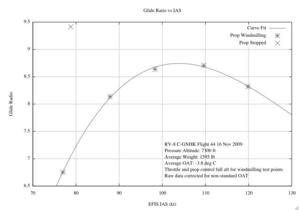 I found that the speed for best glide with the prop windmilling was a bit faster than I had expected. I was expecting it to be about 95 kt at the test weight, but it looks like it is closer to 104 kt. It would probably be closer to 110 kt at gross weight. The glide ratio looks to be about 8.75:1 at the speed for best glide, but I’ll put a value of 8.5:1 in the POH.
I found that the speed for best glide with the prop windmilling was a bit faster than I had expected. I was expecting it to be about 95 kt at the test weight, but it looks like it is closer to 104 kt. It would probably be closer to 110 kt at gross weight. The glide ratio looks to be about 8.75:1 at the speed for best glide, but I’ll put a value of 8.5:1 in the POH.
With the prop stopped, at 80 kt, the glide ratio was about 9.4:1 vs about 7:1 with the prop windmilling at the same speed, which is a significant increase in glide performance. But, given that it is so hard to get the prop to stop turning (I needed to sit just above the stall with full flaps for about 2 minutes to get it to stop), there is little to be gained by attempting to stop the prop. The altitude lost during the steep glide at low speed at full flap would probably never be made up.
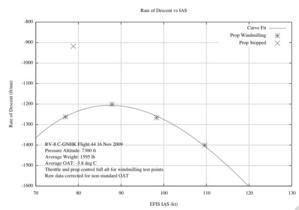 The speed for minimum rate of descent (i.e. the speed that gives the most time to attempt engine restarts, or to make emergency calls on the radio) is about 88 kt.
The speed for minimum rate of descent (i.e. the speed that gives the most time to attempt engine restarts, or to make emergency calls on the radio) is about 88 kt.
Update - 22 Nov 2009 - I was puzzled by a small difference between the results from analyzing one of the test points by hand vs the results I got from my data analysis script. I finally found a Grade 8 math error in the data analysis script (the average of two values is found by ADDING them and dividing by two, not by SUBTRACTING them). Grr. The good news is that once I fixed the error the calculated glide ratios are slightly higher than before.
Update #2 - 22 Nov 2009 - I was curious how high I would need to be before it made sense to slow to just above the stall with full flap to attempt to stop the prop. I looked at the altitude lost during the two minutes or so that it took for the prop to stop, vs the horizontal distance travelled. On average, by the time the prop has stopped, and the airspeed had been increased back to 80 kt, the aircraft was about 850 ft lower than it would have been if the aircraft had been flown at the speed for best glide, with the prop windmilling. After the prop has stopped, the glide performance would be somewhat better than with the prop windmilling, but it would still take about another 11,500 ft of altitude available before the altitude lost while stopping the prop could be made up. Thus in the vast majority of cases there would be no advantage to attempting to stop the prop on my aircraft. I would need to be at least 15,000 ft above ground before it might possibly make sense to attempt to stop the prop.
Flt 44 Report
- Details
- Written by Kevin Horton
- Hits: 3649
Inter-flight activities:
- Installed missing standby alternator control wire.
- Moved fuel flow transducer to be between engine-driven fuel pump and fuel injection servo.
Purpose:
- Standby alternator functional test.
- Fuel flow indication test.
- CHT cylinder-to-cylinder difference check.
- Engine restart tests.
- Glide performance tests.
Events:
- Checked standby alternator performance between 1800 and 2100 rpm.
- Checked fuel flow indication stability.
- Checked CHT values in climb and cruise.
- Conducted engine shutdown and restart tests.
- Conducted glide performance tests with prop windmilling and with prop stopped.
Results:
- The standby alternator maintains essential bus voltage at 12.9 volts with battery master and alternator OFF, and rpm at 1900 rpm or higher. Bus voltage starts to decrease at 1800 rpm (12.8 volts). All essential bus-powered avionics were ON for this test.
- Fuel flow indication is much, much more stable than before.
- All four CHTs are now within 30 deg F of each other the vast majority of the time.
- The engine restarts instantly once the mixture is moved from OFF to rich, with the throttle cracked open. The indications of engine failure at idle are very, very subtle, as the prop maintains the engine rpm at the selected value, and there is very little change in thrust. The fall in EGTs is the clearest indication of engine failure at idle.
- Once the mixture is pulled to OFF, it is extremely difficult to get the prop to stop turning. It persists in windmilling, even as the speed is slowed to the stall with flaps UP. The prop will eventually slow and stop, if flaps are selected to FULL, and the airspeed is held just above the stall for about two minutes. Once the prop was stopped, the airspeed could be increased to about 95 kt before the prop would start turning again.
- The glide performance was measured in reciprocal heading descents, with prop windmilling (mixture OFF, prop control full aft, throttle at idle) at 80, 90, 100, 110 and 120 kt.
- The glide performance was measured in reciprocal heading descents, with prop stopped (prop control full forward, throttle at full) at 80 kt. The glide ratio was approximately 9.4:1, based on hand-recorded data.
- Full glide performance results will be reported later. Update 22 Nov 2009 - The results from this flight were reported here.
New Snags:
- None.
Existing Snags:
- Max rpm still decreases late in the flight.
- Pitch trim speed of movement is slow during a touch and go. Need to try it with the pitch trim speed governor removed.
Glide Performance Testing
- Details
- Written by Kevin Horton
- Hits: 5479
I had a very interesting glide performance test flight late yesterday afternoon.
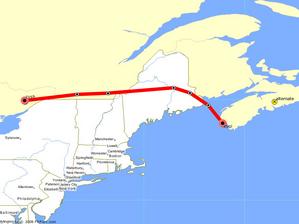 Eventually, I plan to use the RV-8 for quite a few trips back to Yarmouth, NS, to visit my parents and sister. Yarmouth is on the western tip of Nova Scotia, and you have a choice of flying over the Bay of Fundy, or going quite a bit further east to stay over land. The "over land" route adds an hour to the trip, so I am very interested in the Bay of Fundy route.
Eventually, I plan to use the RV-8 for quite a few trips back to Yarmouth, NS, to visit my parents and sister. Yarmouth is on the western tip of Nova Scotia, and you have a choice of flying over the Bay of Fundy, or going quite a bit further east to stay over land. The "over land" route adds an hour to the trip, so I am very interested in the Bay of Fundy route.
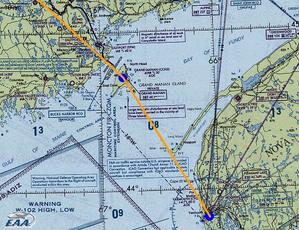 The Bay of Fundy is 24 nm wide if you cross from Grand Manan Island to Digby Neck. I want to know how high I need to be to ensure that I could get to land if the engine failed in the middle of the crossing.
The Bay of Fundy is 24 nm wide if you cross from Grand Manan Island to Digby Neck. I want to know how high I need to be to ensure that I could get to land if the engine failed in the middle of the crossing.
I had assumed that it would be relatively easy to get the engine to stop turning after it was shut down, by reducing the airspeed. I planned to conduct a series of glide tests with the engine stopped at various airspeeds. I would then repeat with prop windmilling near best glide speed, and do another one with the engine running at idle, to see the differences.
After getting airborne yesterday, I did a couple of practice forced landings with the engine at idle, just in case. Then I climbed to 8000 ft, slowly pulled the power to idle, then pulled the mixture to OFF. The prop continued to windmill. I trialed the restart procedure (throttle just above idle, and smoothly push the mixture to RICH). The engine started immediately, as evidenced by the EGTs increasing. I shut it down again, and slowed to the stall, intending to do another restart test using the starter. The prop continued to windmill, even at the stall. I quickly amended the plan of the day to do all glide tests with prop windmilling.
I did two runs at each speed, one at 030 heading, and one at 210 heading (the forcast wind was 300, i.e. at 90 degrees to these headings). I flew test points at 80, 90, 100, 110 and 120 kt), timing the decent from 8000 ft to 7000 ft.
I was still wondering whether it was possible to get the prop to stop, so I climbed to 10,000 ft, pulled the mixture OFF, pushed the throttle to MAX (to increase the torque required to spin the engine), put the flaps fully DOWN, and slowed to just above the stall. The rpm very slowly decreased, and the engine finally stopped about 2 minutes after shutdown. I increased the airspeed, retracted the flaps, and did a glide test at 80 kt from 7300 ft to 6300 ft, then used the starter to restart the engine. I climbed back up and repeated on the reciprocal heading. After this one I very slowly increased the speed, and found that the engine would start spinning again at about 95 kt.
I cleverly left my log card with all the times, fuel quantities, etc in the aircraft, but I do have all the data I recorded on the laptop. But analyzing that data will be more work than expected, as I neglected to put the EFIS altimeter to 29.92.
The original Dynon EFIS software sent barometric altitude in every record, so if you forgot to set 29.92 you simply had a correction to make to the altitude on every record. But they eventually changed the software to alternate between pressure altitude and barometric altitude - one record has pressure altitude, and the next one has barometric altitude. They set a bit at the end of the record to indicate which type of altitude is contained in that record. But, I never updated my data recording script to check that bit, so it simply records every altitude, no matter what kind it is. So if I plot the altitude from this flight, I see that it jig zags up and down. I know what the altimeter setting was - now I need to write a script to correct every other record so I have a clear set of data to analyze.
I did a very quick "back of the envelope" calculation, using the raw data that I recall for 80 kt with prop stopped, and 90 kt with prop windmilling. The glide ratio was about 9.4:1 at 80 kt with prop stopped. It would be slightly better at 90 kt, but there would be a significant risk that the prop would start spinning. The glide ratio at 90 kt with prop windmilling, prop control full aft and throttle at idle was about 8.2:1. These intial estimates will be updated once the full data analysis has been completed.
Lessons learned - Don't count on getting the prop to stop if the engine fails. While it may be possible to get it to stop if the airspeed is kept just above the stall with full flap for two minutes, this yields a steeper glide during those two minutes, and thus it is unlikely that this lost altitude will ever be recovered, even with the slight improvement in glide performance that would occur if the prop could be stopped.
If the prop has stopped on an undamaged engine (engine stoppage due to fuel exhaustion, etc), care should be taken to not increase the airspeed above 90 kt, or the prop may start turning again.
I'll need to be at least 9,500 ft to be able to make land from any point in the crossing of the Bay of Fundy. I can go as high as 13,000 ft for 30 minutes without oxygen, so I'll plan to go to at least 11,000 ft to have some margin for winds, etc.
Update - 22 Nov 2009 - The results from the glide testing were reported here.
Standby Alternator Wiring Fixed
- Details
- Written by Kevin Horton
- Hits: 3661
I was on the road most of the week, which was a crying shame as the weather was pretty much perfect. I would have loved to go flying. Of course the good weather disappeared as soon as the weekend hit.
Yesterday I spent the afternoon at the hangar, attacking the standby alternator voltage regulator power wire. It turns out that I did not install the wire from the standby alternator control relay to the big capacitor by the voltage regulator when I was installing the aircraft wiring. It looks like I didn’t have a suitable ring terminal. I should have put this open item on my big open items list, so I wouldn’t forget it. But, I never did that, so this wire never got installed. Once I got flying, I found that the standby alternator wasn’t working. I finally dug into the snag a a few weeks ago, crawling under the panel with a copy of the wiring diagram and a multimeter. I quickly discovered the problem, and ordered the needed ring terminal.
It sure would have been a lot easier to install this wire when I was doing the rest of the wiring. I had to run it all the way from the right side of the instrument panel to the left landing gear box area. I was ever so happy I had added the access door in the aft wall of the forward baggage area.
It cost me about 2.5 hours and a couple of skinned knuckles, but I got the errant wire installed and tested with a multimeter. I’ll test the standby alternator the next time I go flying.
